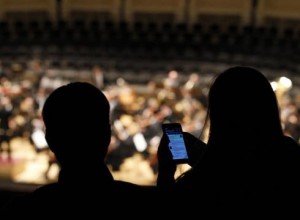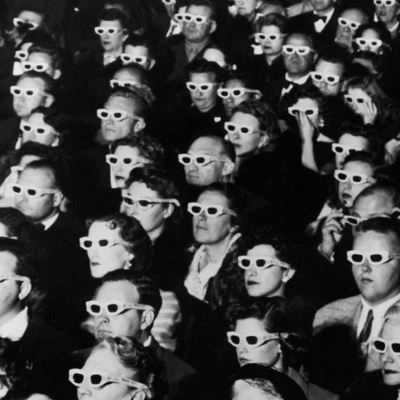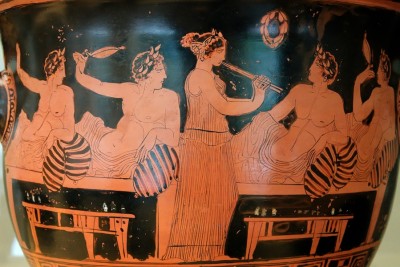Theater in Cyberspace
 When the Lyric Opera of Kansas City, among others, introduced tweet seats granting audience members permission to live tweet from performances, they received a backlash of criticism. “In much the same way that the internet is not theater,” wrote ArtsTechnica blogger Curt Hopkins, “theater isn’t the internet… It’s immersive and transformational. It requires an end of distraction.” The general consensus among theatergoers has been that outside distractions to the theater experience are shameful. Preshow announcements to turn off cell phones are de rigueur, and reminder announcements following intermission aren’t unheard of. Actors have been known to smash through the fourth wall to issue public humiliations, often with the approval of the rest of the audience.
When the Lyric Opera of Kansas City, among others, introduced tweet seats granting audience members permission to live tweet from performances, they received a backlash of criticism. “In much the same way that the internet is not theater,” wrote ArtsTechnica blogger Curt Hopkins, “theater isn’t the internet… It’s immersive and transformational. It requires an end of distraction.” The general consensus among theatergoers has been that outside distractions to the theater experience are shameful. Preshow announcements to turn off cell phones are de rigueur, and reminder announcements following intermission aren’t unheard of. Actors have been known to smash through the fourth wall to issue public humiliations, often with the approval of the rest of the audience.
Ultimately, there seems to be a cultural dissidence between new media and polite theater going. This is perhaps why the tweet seat experiment seemed so shockingly brazen. Here was express authority to blaze up backlit smartphones in the middle of a darkened auditorium, and to what end? To discuss the performance midway with nearby friends? To advertise a moment-to-moment experience to would be ticket buyers? But why not wait until after the performance? Michiko Kakutani for the New York Times complains that an attention-deficient culture encourages attendees to “form judgments before seeing the arc of the entire work.” She suggests that the rise of the net and social media has helped create an environment that demands constant feedback by interactive technology, and that this can, in effect, turn an audience into a “giant focus group” that challenges “the autonomy of the artist.”
 Such criticism attempts to preserve a traditionalist approach to theater going. For the last few hundred years, a popular Cartesian methodology has dictated that an audience should remain silent and separate in one end of a space – the darkened end – granting focal authority to the performers at the other. The intention is that the auditor might be allowed to enter a dreamlike state, viewing the performance through the picture window of the proscenium. From this vantage, the auditor hopes to lose awareness of their self-contained identity (a compounded problem that I will address later) and completely enter the world of the play. And indeed, the great majority of new theaters constructed in the last several hundred years lend their architectural support to this mode of viewing. Given this reasoning, it is only natural that a backlit device, or a turf war over a shared armrest, or latecomers stumbling down the aisle, or a ringing cell phone all become beacons of distraction which threaten to disrupt the tenuously constructed dream state. Artists work so hard to manipulate our experience, by nurturing our pathos and extracting our catharsis, even across the darkened chasm of the space, that the artifice feels fragile and must therefore be defended.
Such criticism attempts to preserve a traditionalist approach to theater going. For the last few hundred years, a popular Cartesian methodology has dictated that an audience should remain silent and separate in one end of a space – the darkened end – granting focal authority to the performers at the other. The intention is that the auditor might be allowed to enter a dreamlike state, viewing the performance through the picture window of the proscenium. From this vantage, the auditor hopes to lose awareness of their self-contained identity (a compounded problem that I will address later) and completely enter the world of the play. And indeed, the great majority of new theaters constructed in the last several hundred years lend their architectural support to this mode of viewing. Given this reasoning, it is only natural that a backlit device, or a turf war over a shared armrest, or latecomers stumbling down the aisle, or a ringing cell phone all become beacons of distraction which threaten to disrupt the tenuously constructed dream state. Artists work so hard to manipulate our experience, by nurturing our pathos and extracting our catharsis, even across the darkened chasm of the space, that the artifice feels fragile and must therefore be defended.
But blogger 99 Seats suggests that condemning texters and tweeters is misguided. “Audiences,” he argues, “are smart… They see plot twists coming a mile off. They know tropes and devices the instant they appear and are rarely fooled… Too often, in theater, they’re getting the same old slop, even when it’s postmodern slop, see where it’s going and would rather engage in something that engages them back. If someone is texting or Twittering during your show, maybe – just maybe – it’s not them. It’s you [ie. the artist].” The accusatory implication is that the relationship of autocratic performer to passive audience can be inert if unoriginal, or at least presumptive. What can fail about this form of communication is a result of the gross amount it expects of its audience. If an audience fails to deliver its attention, the art itself fails, and an antagonistic relationship between self-congratulatory navel-gazer and disdained philistine ensues. Perhaps not unlike this:
While the dreamlike state is not without value, is there not also room for creating performance that actively engages the audience? This was the ultimate point of Hopkins’ criticism. Not that new media is bad, but inelegant integration is an awkward and bald attempt by theater companies to lure technophiles. “Twitter,” he suggests, “will not solve your problems. It won’t solve your declining patronage. It won’t update your unhip image. It won’t make your aging subscriber base young again. Worked as part of a coherent strategy, by a staff and creative leadership that is not petrified by the very things that social media enforces (two-way communication, natural voice, access), it can certainly help. But as long as the generation of art tyrants who have the nation’s theater in crabby lock-down retain their positions, this is unlikely to happen. Their attitude of artistic exceptionalism is a product of an anti-commercialist, arts-for-arts sake origin that went horribly off the rails somewhere along the line, until, today, criticism of any type is interpreted as philistinism.” His point is that the tweet seat idea seems like a half-hearted attempt at incorporating gimmicks that marketers attribute to the new audiences they are trying to develop. But that doesn’t change how awkwardly they would displace the current paradigm.
But what of the coherent strategy that he mentions? The one which incorporates new media and audience engagement. Should we consider organizing such a concept into certain kinds of theater making? Not as a clumsy gimmick that mashes opposing forces, but as a source of inspiration that mirrors what has become integrated in our daily routines? Web 2.0 – or an internet that is not only a hub for content, but an interactive place for social interaction – has made cyberspace a communal experience. “Cyberspace is used by people as a place of congregation,” writes SUNY Morrisville associate sociology professor Kurt Reymers, “and it is in this sense that cyberspace is most closely aligned with definitions of community.” So what if we asked theater to be a place where we didn’t lose ourselves, but we gained awareness of ourselves and our communities, like we might on the net?
 Communal theater is not a new idea. It cannot be said that all generations before ours were made up of disciplined stoics. The symposia of the Romans allowed for intermittent discussions; medieval banquets maintained hierarchical focus on those in power, with theatrical events partly about others witnessing the nobles witness the work; see-and-be-seen Renaissance Europe arguably placed gossip and coquettish flirtation at the center of the event, even allowing audience seating on the stage; all these examples allowed for equal (if not predominant) room for audience interaction and discussion. The audience was permitted to engage with one another, or even with the performers directly. In my mind, this allowance for collectivity more closely mirrors the current Web 2.0 generation, one which contains greater awareness of the group and our network of interconnectedness. And, as incorporated into a performance experience, it places increased focus on social interaction. It demands of an audience to be an active rather than passive participant.
Communal theater is not a new idea. It cannot be said that all generations before ours were made up of disciplined stoics. The symposia of the Romans allowed for intermittent discussions; medieval banquets maintained hierarchical focus on those in power, with theatrical events partly about others witnessing the nobles witness the work; see-and-be-seen Renaissance Europe arguably placed gossip and coquettish flirtation at the center of the event, even allowing audience seating on the stage; all these examples allowed for equal (if not predominant) room for audience interaction and discussion. The audience was permitted to engage with one another, or even with the performers directly. In my mind, this allowance for collectivity more closely mirrors the current Web 2.0 generation, one which contains greater awareness of the group and our network of interconnectedness. And, as incorporated into a performance experience, it places increased focus on social interaction. It demands of an audience to be an active rather than passive participant.
Instead of beginning with a brainstorm of applications for these concepts, what follows is an examination of contemporary audiences. If theater is meant to hold a mirror to life, how do our social behaviors function in a world of new media? In what way is cyberspace a place and how do we use it? How do our real world interactions dialogue with our online avatars? How can a contemporary theater audience – even a traditionalist theater audience – gain an awareness of these complex and interrelated identities? Hopkins suggests that “the internet is not theater,” but can the experience of the internet be examined in the theater?
Note: As a warning, I have expanded the definition of theater beyond the academically formalized, written dramatic form, so that I can be inclusive of its greater sociological functions. Therefore, I begin with the premise that theater is something enacted, something viewed. Traditionalists might take objection with such a broad definition, but I feel it is necessary in order to examine the new ways in which we relate to and communicate with one another. I suspect this will prove valuable in deriving how new media functions and its subsequent application.
Where to next?
- Part Two: The Postmodern Audience
- Part Three: Cyberspace is a Place
- Part Four: Implications and Guiding Questions
